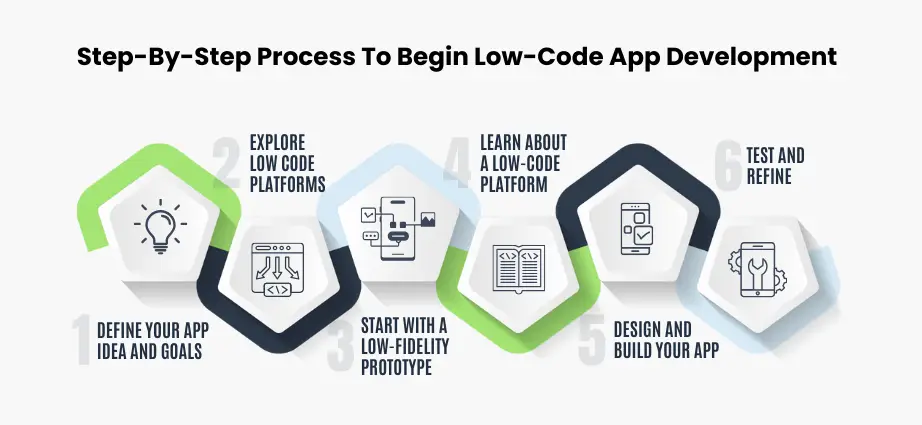Have you ever considered the challenges of developing a top mobile app from scratch? Developers must develop multiple lines of code to translate company concepts into finished goods to complete work quickly and efficiently. The traditional software development approach is tedious as it involves manual coding.
In such cases, low-code mobile app development is a savior for many!
Low-code development is a visual method of app development that relies on pre-built components and drag-and-drop interfaces. Traditional app development requires advanced coding skills, with projects taking six months to one year; low code can be done with basic coding knowledge and work done in a month. the global low-code development market is expected to be worth $22.5 billion in 2024 and to grow at a CAGR of 26.8% to $241.9 billion by the end of 2034.
Many large organizations have already adopted a low-code development approach in their projects, which is becoming popular for many reasons. We will discuss these in today’s blog, so make sure to read everything until the end.
Low-Code Mobile App Development: Definition
Low-code platforms enable drag-and-drop capability and pre-built components for features such as buttons, menus, and data displays. To construct your program’s interface, place these pieces on a virtual canvas.
While some platforms allow you to integrate your code for advanced features, the main functionality is handled by pre-built functions and configurations. This drastically minimizes the amount of code you have to develop from scratch.
Low code enables the rapid development of prototypes to verify app concepts or create internal tools for specific workflows. When deadlines and budgets are tight, low-code development can help you produce functional software more quickly and at a lesser cost.
Low-Code vs No-code vs Full-code App Development: Understanding The Difference
Before understanding the benefits and features of low-code mobile app development, readers must understand the simple difference between low-code, no-code, and full-code app development. The below table can help you choose the best approach for your business:
| Low-Code | No-Code | Full-Code |
|---|---|---|
| Utilizes pre-built components and drag-and-drop capability. Has some coding elements as well | Pre-built components that don't require any coding experience | Traditionally, developers write code from scratch using programming languages such as Java, Python, or Swift |
| While some coding skills can be useful for customization, the fundamental functionality can be developed with minimal coding | No coding skills are necessary. Anyone can construct basic apps using the available tools | Strong programming abilities and a thorough understanding of certain languages and frameworks are necessary |
| Compared to no-code, it offers more flexibility, allowing for some altering of pre-built components and functionality | Provides limited customization. Apps are constructed using the various components and functions on the platform | Allows for the most customization in terms of appearance, features, and functionality. You can create very customized apps tailored to your personal requirements |
| Pre-built components and reduced coding requirements make it faster and less expensive than full-code | The quickest and maybe cheapest approach, as development can be done by anyone without coding skills | The most time-consuming and costly choice because of the necessity for professional engineers and building code from scratch |
| Suitable for simple to somewhat complicated apps with similar features | Ideal for basic apps with low functionality. Complex apps may be difficult to construct with no-code tools | Ideal for extremely complicated apps with many functionalities and big data volumes |
Features of Low-Code App Development
Numerous features come in low-code app development. Integrate them into your next project by hiring the USA’s top Android app development company. Check them out:
- Drag-and-Drop Functionality: This key feature lets you graphically organize pre-built components like buttons, menus, and data displays on a digital canvas. Consider constructing your app interface like a Lego set.
- Model-Based Development: Low-code platforms frequently employ a visual modeling technique. Diagrams and flowcharts can help non-programmers comprehend the app’s logic and data flow.
- Pre-Built Components: Low-code platforms include many pre-built components such as user logins, forms, and maps. These components are easily customizable to match your app’s look and functionality.
- App Templates: Many platforms offer pre-designed app templates for popular use cases such as expenditure monitoring, customer relationship management (CRM), and task management. These can be excellent starting points for quick growth.
- Responsive Design: Low-code platforms ensure your software adapts effortlessly to various screen sizes and devices (phones and tablets) without needing separate code bases.
- External APIs: Many platforms include built-in connectors or APIs, which allow you to link your app to external data sources and services. This will enable you to incorporate features such as social media logins, payment gateways, and cloud storage.
Benefits of Low-code programming
- Develops apps faster than traditional app development.
- Reduce cost with only a few developer requirements; best for startups, small businesses, or projects with limited budgets.
- Empower citizen developers to create simple apps for specific needs. This will free up professional developers to focus on more complex tasks.
- The quick prototyping features of low-code development allow you to validate your app concept early in development.
- Low-code platforms frequently manage underlying infrastructure updates and maintenance, leaving you free to focus on adding new features and functionalities to your program.
How To Get Started with Low-Code App Development

Define your app idea and goals
What problem do you want to solve with your app? Who is your target audience? Clearly outline the need that your app will serve. Set specific, measurable, achievable, relevant, and time-bound goals for your app. What do you hope to achieve with it?
Explore Low Code Platforms
Make a list of the features and functions your app will require. Consider scalability, integration capabilities, and ease of use. Based on your requirements, research various low-code platforms. Search for features, price models, and customer reviews. To get you started, consider these popular options: Mendix, OutSystems, Appian, Caspio, Zoho Creator, and more.
Start with a low-fidelity prototype
Before diving into the low-code platform, sketch out a basic structure and user flow for your app using wireframing tools or pen and paper. This will help you visualize the app’s structure.
Learn about a low-code platform
Most platforms provide extensive training materials, tutorials, and documentation to assist you in mastering the platform’s features and navigating the development environment. Many platforms include sample apps and templates to demonstrate the platform’s capabilities and serve as a starting point for your development.
Design and Build Your App
Create your app’s interface using the platform’s drag-and-drop capability and pre-built components. Determine what data your app will use and how it will be stored. Use the platform’s tools to define the logic and workflows for your app.
Test and refine
Test your app rigorously on various devices to ensure appropriate functionality and a consistent user experience. Request input from potential users or coworkers to identify areas for improvement and iterate on your app’s design and functionality.
Deploy, launch, and maintain your application
Follow the platform’s instructions to prepare your app for submission to app stores (such as the Apple App Store or the Google Play Store). If your app is designed for internal use within your organization, the platform may provide options for private distribution within your network.
Low-code platforms provide for easy maintenance and updates. Use analytics to monitor user activity and make data-driven changes to your app over time.
Industries Where Low-Code App Development Can Be Used
- Customer Relationship Management (CRM): Manage customer interactions, save contact information, and simplify sales procedures.
- Expense Management Apps: Track staff costs, automate approvals, and streamline reimbursements.
- Project Management Tools: Assign assignments, track progress, work with others, and meet deadlines.
- Appointment Booking Apps: Allow consumers to plan appointments, manage their bookings, and receive reminders.
- Field Service Management Apps: Dispatch technicians, manage work orders, and monitor field service activities.
- E-commerce Storefronts: Set up online storefronts to sell things and manage customer orders.
- Loyalty Programs And Rewards Apps: Engage customers with loyalty programs, provide incentives, and promote brand loyalty.
Why Choose Us For Low Code App Development
Low-code mobile app development is a powerful and easy technique for creating mobile applications. Understanding its strengths and limits allows you to assess whether it meets your project’s requirements and development goals. Find out how Echoinnvoate IT can help you create outstanding applications with the ultimate powers of low code:
- User-Friendly Interface: Expect an easy-to-use interface for all your users
- Adaptability: Create various applications, including enterprise solutions and customer-facing apps.
- Scalability: We offer solutions built to expand your company and meet changing needs.
- Security: Provides strong security measures to secure your data and applications.
- Guidance and resources: You will have access to a wealth of information and tools to help you navigate the development process.
Industries Where Low-Code App Development Can Be Used
- Customer Relationship Management (CRM): Manage customer interactions, save contact information, and simplify sales procedures.
- Expense Management Apps: Track staff costs, automate approvals, and streamline reimbursements.
- Project Management Tools: Assign assignments, track progress, work with others, and meet deadlines.
- Appointment Booking Apps: Allow consumers to plan appointments, manage their bookings, and receive reminders.
- Field Service Management Apps: Dispatch technicians, manage work orders, and monitor field service activities.
- E-commerce Storefronts: Set up online storefronts to sell things and manage customer orders.
- Loyalty Programs And Rewards Apps: Engage customers with loyalty programs, provide incentives, and promote brand loyalty.
FAQs-An Ultimate Guide to Low Code Mobile App Development
Why is custom mobile app development crucial for eCommerce businesses?
Custom mobile app development allows eCommerce businesses to tailor the user experience, providing unique features and functionalities that cater specifically to their customers’ needs. This personalization can lead to increased customer satisfaction and loyalty.
How does a custom mobile app benefit eCommerce businesses compared to a generic app?
A custom mobile app offers enhanced flexibility and scalability, enabling eCommerce businesses to adapt quickly to market changes and customer demands. Unlike generic apps, custom apps can integrate seamlessly with existing systems and offer specialized features that differentiate the brand from competitors.
What role does custom mobile app development play in improving customer engagement?
Custom mobile apps can include targeted push notifications, personalized recommendations, and streamlined checkout processes, all of which enhance customer engagement. By providing a more interactive and user-friendly experience, custom apps help retain customers and encourage repeat business.



